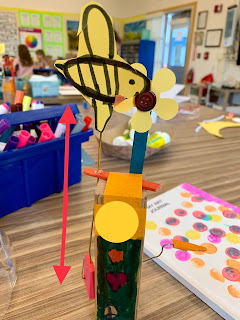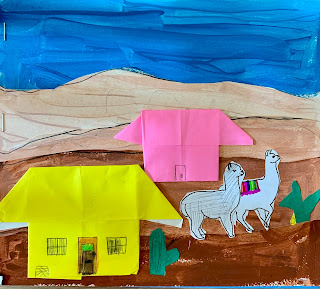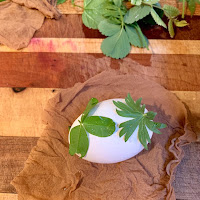Transitional Kindergarten: Zigzag Doll
ZIGZAG by Robert D. San Souci, a story about a doll maker who created Zigzag and placed him on the shelf for the night. After the doll maker left, Zigzag got pushed off the shelf by the other dolls. Zigzag ultimately ended up outside in the trash bin and had to climb his way out. The book does have a happy ending, as three mice found him a nice home with a happy little girl, and his zigzagged mouth turned into a happy smile.
The beginning of the story reveals that ZIGZAG was made from scraps of fabrics. TK students created their own dolls. Students picked out fabrics, used fabric scissors for cutting, and planned out and glued down their fabric pieces. Some dolls ended up with four legs, tails, and hats, and hair hanging off the edges, but that’s what makes these dolls so special! They make you smile!
Kindergarten: STEAM The Cranky Machine
This is Kindergarten Arts/Science integration at its best. Students learned about a variety of push and pull forces. Once students had grasped the basic concept of forces they were ready to build their “cranky", a little machine with a crank, an axle and a piston animating one part of two artistic forms.
Students persevered through the technical steps of engineering a crank and piston and loved the artistic challenge in creating two forms telling a story with one moving and one still part. Kindergarten students went full STEAM ahead into this hands on learning experience.
What an amazing learning opportunity for students, teachers and family volunteers!
1st GRADE: Arts Integration and STEAM: Exploration of Sound: What is Sound?
This 1st grade unit of Arts Integration and STEAM support the Next Generation Science Standards of "Sound". Arts integration is an important part of the transition to the Common Core Standard. Arts integration supports deeper learning and thinking by connecting the core subject to an art form while maintaining the integrity of both the core subject and the artistic process.
First grade students were guided through a variety of hands-on science experiments to explore sound. Students have been learning that sound comes from vibrations.
First grade students were introduce to the Rainstick music instrument. The rainstick is believed to have been invented by the Aztecs (Native People from Mexico) and was played in the belief it could bring about rainstorms. Rainsticks are usually made from any of several species of cactus. The cacti, which are hollow, are dried in the sun. The spines are removed, then driven into the cactus like nails. Pebbles or other small objects are placed inside the rainstick, and the ends are sealed. A sound like falling water is made when the rainstick has its direction changed to a vertical position.
Thank you to the first grade community for helping us collecting materials for our rainsticks. Instead of cacti we used mostly recycled materials such as paper towel rolls and paper bags to build our rainsticks. Students rolled tight tinfoil rolls and coiled them. Students inserted the tinfoil coils together with 1/3 cup of rice into the cardboard tube. After securing end caps at both sides of the tube students practice making rain-like sounds. To beautify the instrument students painted their rainsticks and added ribbons just like the rainsticks created by artists in Mexico.
This 1st grade unit of Arts Integration and STEAM support the Next Generation Science Standards of "Sound". Arts integration is an important part of the transition to the Common Core Standard. Arts integration supports deeper learning and thinking by connecting the core subject to an art form while maintaining the integrity of both the core subject and the artistic process.
First grade students were guided through a variety of hands-on science experiments to explore sound. Students have been learning that sound comes from vibrations.
First grade students were introduce to the Rainstick music instrument. The rainstick is believed to have been invented by the Aztecs (Native People from Mexico) and was played in the belief it could bring about rainstorms. Rainsticks are usually made from any of several species of cactus. The cacti, which are hollow, are dried in the sun. The spines are removed, then driven into the cactus like nails. Pebbles or other small objects are placed inside the rainstick, and the ends are sealed. A sound like falling water is made when the rainstick has its direction changed to a vertical position.
2nd grade: Arpilleras, Peruvian Folk Art
Arpilleras or "cuadros" are exquisitely colorful, detailed, hand-sewn, three dimensional textile pictures. Arpilleras illustrate the stories of the lives of the women of the"pueblo jovenes" of Lima, Peru and provide essential income for their families. The arpilleras tell stories of planting and harvesting potatoes, tomatoes, cabbages, grapes, corn; stories of spinning and weaving wool; stories of country life, of tending llamas, alpacas, sheep and goats; stories of weddings and fiestas.
Students picked a primary or secondary color as the main color for their arpilleras. Using white in addition to the main color, students mixed tints, from dark to light to create a sense of space to depict the Andes Mountains. Students were introduced to the concept of complementary colors to achieve effective color contrast and vibrancy between the hills and the Peruvian houses and other details. Students folded the houses for their arpilleras in an origami style. Some students experimented folding smaller and smaller houses to convey perspective. Students created their own narratives adding llamas, alpacas, flowers, etc. to their arpilleras.
Arpilleras or "cuadros" are exquisitely colorful, detailed, hand-sewn, three dimensional textile pictures. Arpilleras illustrate the stories of the lives of the women of the"pueblo jovenes" of Lima, Peru and provide essential income for their families. The arpilleras tell stories of planting and harvesting potatoes, tomatoes, cabbages, grapes, corn; stories of spinning and weaving wool; stories of country life, of tending llamas, alpacas, sheep and goats; stories of weddings and fiestas.
Students picked a primary or secondary color as the main color for their arpilleras. Using white in addition to the main color, students mixed tints, from dark to light to create a sense of space to depict the Andes Mountains. Students were introduced to the concept of complementary colors to achieve effective color contrast and vibrancy between the hills and the Peruvian houses and other details. Students folded the houses for their arpilleras in an origami style. Some students experimented folding smaller and smaller houses to convey perspective. Students created their own narratives adding llamas, alpacas, flowers, etc. to their arpilleras.
Students picked a primary or secondary color as the main color for their arpilleras. Using white in addition to the main color, students mixed tints, from dark to light to create a sense of space to depict the Andes Mountains. Students were introduced to the concept of complementary colors to achieve effective color contrast and vibrancy between the hills and the Peruvian houses and other details. Students folded the houses for their arpilleras in an origami style. Some students experimented folding smaller and smaller houses to convey perspective. Students created their own narratives adding llamas, alpacas, flowers, etc. to their arpilleras.
3rd Grade: Fibonacci Spiral
What is Fibonacci?
Fibonacci was an Italian man who studied math and theories back in the 11th century. He discovered a pattern called the Fibonacci sequence. It's a series of numbers that starts with 0 and 1, and each number after is found by adding the two previous numbers (1, 1, 2, 3, 5, 8, 13, 21, 34, 55...)
The curve of an equiangular spiral has a constant angle between a line from origin to any point on the curve and the tangent at that point, hence its name. ... Fibonacci spirals, Golden spirals and golden ratio-based spirals often appear in living organisms.
Third grade students learned that math and geometry are fundamental building blocks for art and design through the Fibonacci sequence and the Golden Ratio. In geometry, a golden spiral is a logarithmic spiral whose growth factor is φ, the golden ratio. That is, a golden spiral gets wider (or further from its origin) by a factor of φ for every quarter turn it makes. Students used centimeters as the unit of measure to cut squares out of different colored construction paper following the Fibonacci sequence up to the number 21. Students linked their square designs together and drew their golden ratio spiral to finish the graphic art pieces. The curve of an equiangular spiral has a constant angle between a line from origin to any point on the curve and the tangent at that point, hence its name. ... Fibonacci spirals, Golden spirals and golden ratio-based spirals often appear in living organisms.
4th Grade: Fibonacci Sequence Circle Design
Visual arts integration with math and geometry. Fourth grade students implemented the mathematical Fibonacci sequence and golden ration in aesthetically pleasing, abstract and representational circle designs. The art world has felt the influence of the Golden Ratio for centuries. Also known as the Golden Section or the Divine Proportion, this mathematical principle is an expression of the ratio of two sums whereby their ratio is equal to the larger of the two quantities. Many works of art have been designed using the golden ratio. For example Da Vinci's Mona Lisa. Students were fascinated how this mathematical formula discovered by Fibonacci in the 11th century is still used in visual arts, architecture and design today. For example the iconic logos Apple and Twitter were both designed with circles following the Fibonacci sequence.
Students practiced using a compass to draw circles with radii following the Fibonacci sequence. Students used different colored construction paper to create creative, visual pleasing circle designs.
Would you like to read more about the Fibonacci Sequence? https://www.canva.com/learn/what-is-the-golden-ratio/
Visual arts integration with math and geometry. Fourth grade students implemented the mathematical Fibonacci sequence and golden ration in aesthetically pleasing, abstract and representational circle designs. The art world has felt the influence of the Golden Ratio for centuries. Also known as the Golden Section or the Divine Proportion, this mathematical principle is an expression of the ratio of two sums whereby their ratio is equal to the larger of the two quantities. Many works of art have been designed using the golden ratio. For example Da Vinci's Mona Lisa. Students were fascinated how this mathematical formula discovered by Fibonacci in the 11th century is still used in visual arts, architecture and design today. For example the iconic logos Apple and Twitter were both designed with circles following the Fibonacci sequence.
Students practiced using a compass to draw circles with radii following the Fibonacci sequence. Students used different colored construction paper to create creative, visual pleasing circle designs.
Would you like to read more about the Fibonacci Sequence? https://www.canva.com/learn/what-is-the-golden-ratio/












































